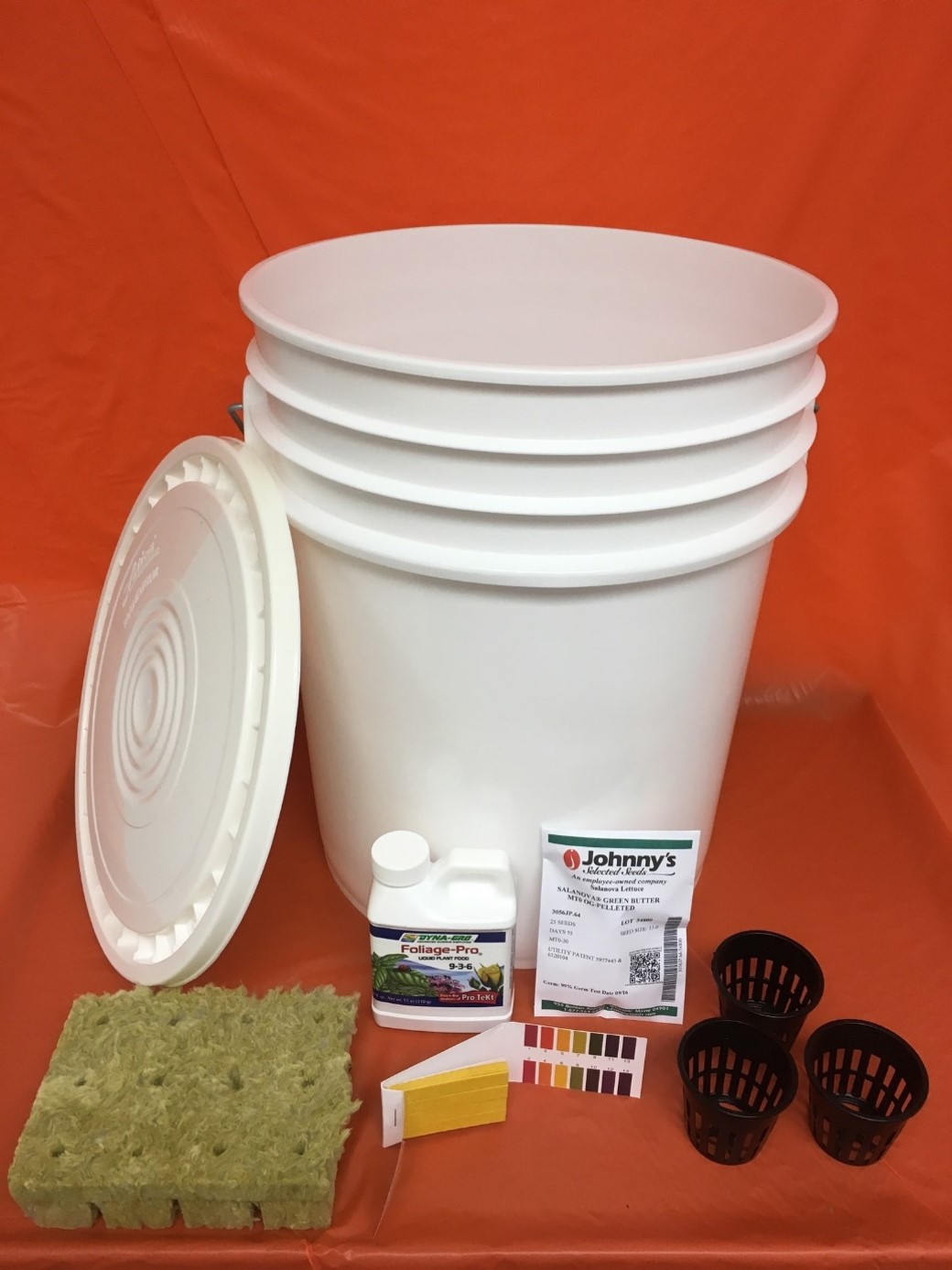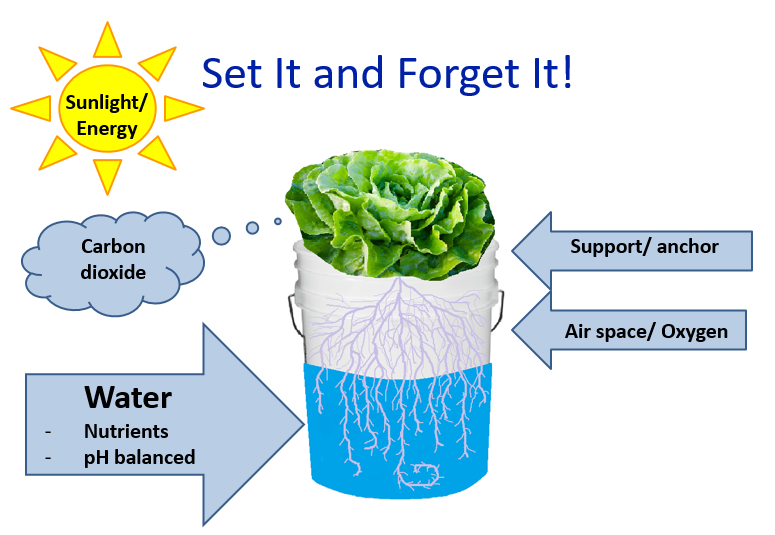Set it and forget it hydroponics accurately explains how simple growing your own food hydroponically can be! Research from Dr. Bernard A. Kratky at the University of Hawaii explains “Three Non-circulating Hydroponic Methods for Growing Lettuce.” Here is a breakdown of how to grow your own hydroponic lettuce in a bucket. The following steps use a 5 gallon bucket with a lid. This method  can be modified using almost any container that holds volume; wider containers are better than taller so roots can reach water. You can use a lid to suspend your plants, or you can float your plants on top of the nutrient solution with a foam board as long as there is a little room for air flow to the root zone. Just note that lettuce will need 1-1.5 gallons of water from seed starting to harvest.
can be modified using almost any container that holds volume; wider containers are better than taller so roots can reach water. You can use a lid to suspend your plants, or you can float your plants on top of the nutrient solution with a foam board as long as there is a little room for air flow to the root zone. Just note that lettuce will need 1-1.5 gallons of water from seed starting to harvest.
Hydroponic growing is possible by providing all of the basic needs of the plant: light, water, a pH balanced nutrient solution, structural support, and air flow. Hydroponics can be as simple as making a microwave dinner or as complex as operating a Michelin Star restaurant. Water and land use are extremely efficient in hydroponic systems, making the method well suited for urban food production, personal or commercial. The method presented is intended to present one of the simplest, most affordable methods of hydroponic growing so you can get your feet wet and determine if you want to grow your own, or stick to the grocery.
Materials
- 5 gallon bucket and lid (avoid white to reduce algae issues)
- 2 inch hole saw
- Drill
- Permanent marker
- Hydroponic nutrients (general formula or leafy/ foliage formula)
- pH down – white vinegar
- Teaspoon
- Stirrer

- pH strips/meter
- Lettuce seeds
- 2 inch net cups
- Grow cubes (Rockwool or Oasis)
- EC/ TDS meter (not required, but recommended for more advanced growing systems and crops like tomatoes)
- If growing indoors:
- Artificial light (see blog) – T5 High Output Fluorescent Grow Light or energy efficient, wavelength specific LEDs
- Fan may be needed to reduce tip burn by increasing airflow and transpiration
Starting Seeds
- Prepare water to soak grow cubes
- Soak grow cubes in water until saturated
- Place seeds into cubes (1-2 seeds each)
- You can either keep seeds germinating in a container with high humidity
- Transplant to bucket once seedling has emerged
- OR you can start the seeds in your bucket, but you may need to help maintain high moisture levels while the seed is germinating
- MAKE SURE THE BOTTOM OF THE GROW CUBES STAY IN CONTACT WITH THE NUTRIENT SOLUTION
Building Your Bucket
- Trace net pot on lid in 3 places

Plants need light, water, and nutrients to support growth. In hydroponics, growers must replace the qualities of soil by providing support for roots and oxygen in the root zone. - Place lid on bucket
- Hold bucket in place, place drill over traced circle, and steady the drill over the lid while gently guiding the drill into the lid
- Place net pot in each hole
- Set bucket in sunny location during your lettuce growing season or under artificial grow lights
- Florida lettuce grows well outside during the cool season from October – March (see Florida Vegetable Gardening Guide)
- Season extension achieved with shade structures or by growing indoors under artificial grow lights. Here is a blog about artificial grow lights for home vegetable production!
- Fill bucket with water until it touches the bottom of the net pot (~ 5 gallons)
- Optional step: Measure Electrical Conductivity (EC) or Total Dissolved Solids (TDS)
- Meter recommended if interested in more advanced techniques, otherwise continue to next step
- Add nutrients to water to total EC of ~1250 µS/cm or ~800 ppm
- CHECK LABEL RECOMMENDATIONS FOR NON-CIRCULATING HYDROPONICS
- ~1 tsp/gallon nutrient solution (5 tsp/5 gallons)
- Measure pH of solution – use pH strips or meter
- Adjust pH of solution to ~5.6- 6.0
- ~2 tsp/gallon if using white vinegar (10 tsp/5 gallons)(formula may differ depending on qualities of local water supply)
- Place lid on bucket
- Place lettuce seedlings in net cups – make sure bottom of seedling is touching the nutrient solution
- SET IT & FORGET IT until you are ready to harvest your lettuce!
Video Tutorials
Set it and Forget it Hydroponics for personal/household consumption (~3 heads per grow cycle):
Plastic Wading Pool Hydroponics (~18 heads/ grow cycle): Central Florida Gardening- Wading Pool Hydroponics
Hydroponics for community consumption (~32 heads per grow cycle): Building a Floating Raft Hydroponic Garden
Frequently Asked Questions
Can you grow tomatoes or other flowering or fruiting crops using this method? While it is certainly possible to grow tomatoes using this method, other hydroponic growing systems are better suited, such as dutch buckets, lay flat bags, or trench systems. Long term crops use A LOT of water and nutrients, so you need an active hydroponic system with pumps and irrigation emitters. Additionally, nutritional needs change through flowering and fruiting crop development, requiring more grower management. Lastly, crops like tomatoes, peppers, and cucumbers need pruning and training to grow optimally in hydroponic systems.
UF/IFAS Small Farms and Alternative Enterprises has great resources to support growers looking to grow more advanced crops hydroponically!
Where should I put my seedlings? An ideal seedling for transplant is short, strong, and stocky with good root development. Whether the seeds start in a light or dark environment, they need to be exposed to light as soon as they emerge from the seed. If the newly emerged seedling is searching for light, it will stretch out. You can cover your seed with vermiculite in the grow cubes to grow stronger seedlings. Humidity must remain high during the seedling stage. You can start seeds under artificial lights. See the blog on artificial lights, or check out this video for a simple method for starting seeds under light at home.
Are there alternatives to grow cubes? You do have the option of starting seedlings in a seed starting growing media for this system as long as you start with a good root ball. Do not used a loose growing media for seedlings that will be used in hydroponic systems with pumps and emitters to help prevent clogging. Grow cubes are single use.
Nutrient sources? Hydroponics requires that all essential nutrients are supplied in the fertilizer since the roots cannot access nutrients that would usually be available in the soil. There are many complete hydroponic nutrient solutions available. Liquid blends do not require aggressive mixing but you do have to pay to ship extra weight. Granular blends require mixing. There are some nutrients that come in two bottles, A and B, that also work well. In areas with high levels of calcium and magnesium in the water, you can provide all nutrients using 2 tsp. of miracle gro all purpose formula plus 1 tsp. of epsom salts per gallon of water. Unfortunately, I am not familiar with nutrient access and availability in developing countries. Email me if you have resources to share (hwooten@ufl.edu).
How to harvest? This particular growing method is intended to grow one cycle of lettuce, then start over again. You may be able to extend your lettuce season by harvesting only the outside leaves very carefully. You can also just hack off the entire head. Regrowth can occur, but it is low quality and bitter as your bucket is at its end.
Shout out to soil and sunlight! The soil and the sun have unique properties that simply cannot be replaced, but good soil and quality sunlight are not always available for food production when and where needed. Unfortunately, continued population growth and urbanization is outpacing the rate at which we can continue to grow more food using less space. Hydroponics can produce the same yields as conventional agriculture using 80% less space and 95% less water and can be successful in non- traditional growing spaces. Hydroponics is more energy intensive.
 6
6
